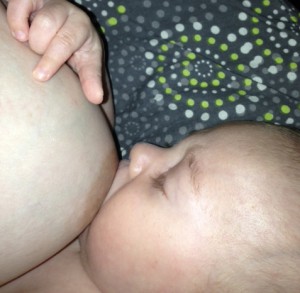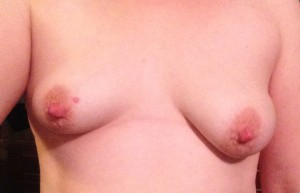
Baby and mom breastfeeding with IGT
Your breast anatomy was determined even before you were born. During the early months of fetal development, breast buds are formed. If the breast buds do not develop properly in utero, development in puberty may not occur normally. Breasts may develop minimally or not at all. And future milk making ability may be compromised.
It’s important to emphasize that breast size alone is not the entire story. Breasts, nipples and areolas come in a wide variety of shapes and sizes. Breast size differences among women is not the result of more or less glandular tissue; it is the result of more or less fat in the breast. Generally speaking, the size of your breasts has no bearing on milk production. But when the size and shape of the breasts are impacted by the lack of glandular tissue, (milk producing structures in the breast) milk supply can be affected.
Breast hypoplasia, also known as “insufficient glandular tissue” or IGT, is a rare condition that results in a mother’s inability to produce enough milk for her baby. These mothers have breasts that may be quite large or they may be very small, but they all lack glandular tissue that is required to produce milk in ample quantities.
It is not always easy to diagnose IGT. The appearance of the breasts can be a clue, but a complete health history of the mother-including pregnancy and lactation- is required to determine true breast hypoplasia. In addition, breast surgeries can mask visible signs of hypoplasia, making the health history even more important. Here are three very different histories. But all of these women have IGT.
“I didn’t develop like other girls did in high school. I always had very small breasts and have been uncomfortable with my body. When I got pregnant last year, I planned on breastfeeding. My breasts were sore and tender throughout the entire pregnancy but I never had to change bra sizes.”
“I have always had a big chest. By the time i was in the 4th grade I had B cups and my family attempted to get me to wear a bra. I refused to wear one until 7th grade, by which time I was a C cup. The older I got the more I noticed that my breasts were not firm and perky like everyone else’s seemed to be. I assumed it was because mine were just extremely saggy from refusing to wear a bra for so long.”
“I never really got breasts. At all. I looked like a boy. When I was old enough I had breast augmentation surgery (implants) so I could look like other adult women. When I had my baby and he lost so much weight, everyone told me it couldn’t be because of the implants. Finally I found a lactation consultant who asked the right questions and I learned I have IGT.”
As mentioned above, breasts come in many shapes and sizes. Variation is normal and there isn’t one perfect breast shape for breastfeeding or milk supply. But there are some variations that may indicate hypoplasia or IGT. Can anyone predict a particular woman’s ability to make enough milk for her baby based on a visual exam of her breasts? Probably not. Although an expert IBCLC (lactation consultant) would be able to identify a potential likelihood of insufficient milk production based on appearance.
The shape of the breasts, the fat distribution, proximity of breasts to one another, symmetry and nipple placement are all indicators of normal breast development and milk production. If the IBCLC notices any deviation from normal, she may suspect IGT. Some IGT indicators include cone-shaped breasts, (think triangle) widely spaced breasts, one breast much bigger than the other, breasts that lay flat against the rib cage (tubular breasts), areola and nipples pointing straight down and/or very widely spaced breasts.
A few lovely breastfeeding ladies have volunteered to show you some examples of IGT:



Remember breast shape alone does not mean you have IGT! I have met women with some of the above characteristics that developed a full milk supply! Even if you discover you do, in fact, have breast hypoplasia, it’s still possible to breastfeed your baby. Many women with IGT breastfeed their babies for months or years with appropriate supplementation.
If you have a suspicion that IGT may explain your breasts or your past difficulties with breastfeeding, please seek support from an IBCLC very soon, even during your pregnancy, She can help you maximize your milk producing potential and avoid unnecessary newborn weight loss.
Thank you to all the moms from the IGT and Low Milk Supply facebook group who have courageously shared their stories and their breasts to help other mothers!
See also: IGT: Four Stories from Moms Who Have Been There, Low Milk Supply Stories
